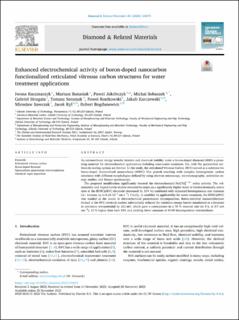| dc.contributor.author | Kaczmarzyk, Iwona | |
| dc.contributor.author | Banasiak, Mariusz | |
| dc.contributor.author | Jakobczyk, Pawel | |
| dc.contributor.author | Sobaszek, Michał Sobaszek | |
| dc.contributor.author | Strugala, Gabriel | |
| dc.contributor.author | Seramak, Tomasz | |
| dc.contributor.author | Rostkowski, Pawel | |
| dc.contributor.author | Karczewski, Jakub | |
| dc.contributor.author | Sawczak, Mirosław | |
| dc.contributor.author | Ryl, Jacek | |
| dc.contributor.author | Bogdanowicz, Robert | |
| dc.date.accessioned | 2024-01-08T14:38:22Z | |
| dc.date.available | 2024-01-08T14:38:22Z | |
| dc.date.created | 2023-12-22T12:57:22Z | |
| dc.date.issued | 2024 | |
| dc.identifier.citation | Diamond and Related Materials. 2024, 141, 110673. | en_US |
| dc.identifier.issn | 0925-9635 | |
| dc.identifier.uri | https://hdl.handle.net/11250/3110428 | |
| dc.description.abstract | An extraordinary charge transfer kinetics and chemical stability make a boron-doped diamond (BDD) a promising material for electrochemical applications including wastewater treatment. Yet, with flat geometrical surfaces its scaling options are limited. In this study, the reticulated Vitreous Carbon (RVC) served as a substrate for boron-doped diamondized nanocarbons (BDNC) film growth resulting with complex heterogeneity carbon structures with different morphologies defined by using electron microscopy, microtomography, activation energy studies, and Raman spectroscopy.
The proposed modification significantly boosted the electrochemical Fe(CN)63−/4− redox activity. The voltammetry and impedimetric studies revealed its origin as a significantly higher share of electrochemically active sites at the BDNC@RVC electrode (increased by 114 %) combined with enhanced heterogeneous rate constant (2× increase up to 8.24·10−4 cm s−1). Finally, to establish its applicability for water treatment, the BDNC@RVC was studied as the anode in electrochemical paracetamol decomposition. Boron-enriched nanoarchitecture formed at the RVC electrode surface substantially reduced the oxidation energy barrier manifested as a decrease in activation overpotential by 212 mV, which gave a consequence in a 78 % removal rate (in 4 h, at 0.7 mA cm−2), 12 % higher than bare RVC and yielding lower amounts of APAP decomposition intermediates. | en_US |
| dc.language.iso | eng | en_US |
| dc.rights | Navngivelse 4.0 Internasjonal | * |
| dc.rights.uri | http://creativecommons.org/licenses/by/4.0/deed.no | * |
| dc.title | Enhanced electrochemical activity of boron-doped nanocarbon functionalized reticulated vitreous carbon structures for water treatment applications | en_US |
| dc.title.alternative | Enhanced electrochemical activity of boron-doped nanocarbon functionalized reticulated vitreous carbon structures for water treatment applications | en_US |
| dc.type | Peer reviewed | en_US |
| dc.type | Journal article | en_US |
| dc.description.version | publishedVersion | en_US |
| dc.rights.holder | © 2023 The Authors. Published by Elsevier B.V. | en_US |
| dc.source.volume | 141 | en_US |
| dc.source.journal | Diamond and related materials | en_US |
| dc.identifier.doi | 10.1016/j.diamond.2023.110673 | |
| dc.identifier.cristin | 2217260 | |
| dc.relation.project | NILU: 120133 | en_US |
| dc.source.articlenumber | 110673 | en_US |
| cristin.ispublished | true | |
| cristin.fulltext | original | |
| cristin.qualitycode | 1 | |

